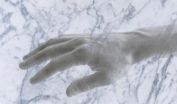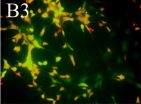(Press-News.org) Large amounts of carbon dioxide equivalents taken up by plants on land are returned to the atmosphere from aquatic environments. This is the conclusions from a study carried out by two students at Linköping University, Sweden.
As students at the Master program Science for Sustainable Development in Linköping, Bala Panneer Selvam and Sivakiruthika Natchimuthu, did a thorough investigation of greenhouse gas emissions from many types of inland waters in India under supervision by Dr Lakshmanan Arunachalam, Tamil Nadu Agricultural University, India, and Dr David Bastviken, Linköping University, Sweden.
The findings were that emissions of carbon dioxide equivalents (as methane and carbon dioxide) from lakes, running water, dams, ponds, and wells correspond to on an average 42 % of the expected natural carbon sink in India. This carbon sink may therefore be smaller than expected, illustrating that we do not have full knowledge on the natural greenhouse gas balance.
Hence, it may be better to try to reduce fossil carbon emissions rather than hoping that natural environments have a large capacity to take up emitted carbon. Methane accounted for 71% of the emitted aquatic CO2 equivalents and this opens a way to reduce these emissions by reducing the water pollution in terms of nutrients and organic material.
It is important to realize these findings are not specific for India – all countries should consider aquatic emissions in their greenhouse gas balances. This also illustrates how student projects can contribute to science.
INFORMATION:The study was recently published in the scientific journal Global Change Biology, with the title: Methane and carbon dioxide emissions from inland waters in India - Implications for large scale greenhouse gas balances.
Lots of carbon dioxide equivalents from aquatic environments
2014-03-24
ELSE PRESS RELEASES FROM THIS DATE:
A towel less: How psychologists harness sociability to cut waste
2014-03-24
Hotel guests can be gently persuaded to reduce the number of towels they use each day, psychology researchers at the University of Luxembourg have found. With fewer towels to wash, this reduces the waste of water, energy and detergent. This is good news for the environment and it cuts costs, so enabling hotels to reduce prices.
Two hotels in Swiss and Austrian ski resorts helped with an experiment in early 2013. Three different signs were placed separately in different bathrooms, all of which gently reminded guests of the environmental impact of towel use. However, one ...
Microfluidic device with artificial arteries measures drugs' influence on blood clotting
2014-03-24
A new microfluidic method for evaluating drugs commonly used for preventing heart attacks has found that while aspirin can prevent dangerous blood clots in some at-risk patients, it may not be effective in all patients with narrowed arteries. The study, which involved 14 human subjects, used a device that simulated blood flowing through narrowed coronary arteries to assess effects of anti-clotting drugs.
The study is the first to examine how aspirin and another heart attack prevention drug respond to a variety of mechanical blood flow forces in healthy and diseased arteries. ...
Would you believe your hand could turn into marble?
2014-03-24
This news release is available in German.
The study was published in the international scientific journal PLOS ONE on 13 March 2014.
To induce an illusory perception of the material properties of the hand, a group of neuroscientists from Bielefeld University, the Max-Planck Institute for Biological Cybernetics (Germany), and the University of Milano-Bicocca (Italy) asked volunteers to sit with their hands lying on a table in front of them. They repeatedly hit the participants' right hands gently with a small hammer while replacing the natural sound of the hammer ...
Hot nanoparticles for cancer treatments
2014-03-24
This news release is available in German. If you put your hand over a switched-on torch in the dark, it appears to glow red. This is because long-wavelength red light beams penetrate human tissue more effectively than short-wavelength blue light. ETH Zurich researchers exploit this fact in a new kind of nanoparticles: so-called plasmonic particles, which heat up when they absorb near-infrared light. This could enable them to kill tumour tissue with heat, for instance.
Gold is a popular material for nanoparticles used therapeutically, as it is well tolerated and ...
Nature Immunology study finds novel population of neutrophils
2014-03-24
Case Western Reserve University researchers have discovered a novel population of neutrophils, which are the body's infection control workhorses. These cells have an enhanced microbial killing ability and are thereby better able to control infection.
Neutrophils, the body's most abundant type of white blood cells, have long been regarded as first responders that kill fungi, bacteria, and other pathogens. In a study published in the February issue of Nature Immunology, Case Western Reserve researchers explain that they have found the mechanism of action of a newly discovered ...
GDNF transfection promotes neuronal differentiation of bone marrow mesenchymal stem cells
2014-03-24
Studies have shown that the differentiation rate of grafted bone marrow mesenchymal stem cells into mature neuron-like cells is very low. Therefore, it is very important to establish an effcient and stable induction protocol to promote the differentiation of bone marrow mesenchymal stem cells into neuron-like cells in vitro and elucidate the mechanisms underlying differentiation for the treatment of central nervous system diseases. Jie Du and colleagues from Sichuan University in China found that glial cell line-derived neurotrophic factor/bone marrow mesenchymal stem cells ...
Electroacupuncture effect on depression and variation of polygenes expression
2014-03-24
Preliminary basic research and clinical findings have demonstrated that electroacupuncture therapy exhibits positive effects in ameliorating depression. However, most studies of the underlying mechanism are at the single gene level; there are few reports regarding the mechanism at the whole-genome level. Using a rat genomic gene-chip, Dr. Dongmei Duan and co-workers from General PLA Hospital in China profiled hippocampal gene expression changes in rats after electroacupuncture therapy. Electroacupuncture therapy alleviated depression-related manifestations in the model ...
Tecnalia presents a smart home able to detect symptoms of neurodegenerative diseases
2014-03-24
The world population is rapidly ageing, which means the number of disabled and dependent people is increasing since these rates increase with age, particularly after the age of 80. This is the context in which the Tecnalia centre for applied research has designed a system of sensors which when fitted in a home, allows a person's habits and activities to be monitored and any changes in his/her habits and activities that could be a symptom of disorders relating to neurodegenerative diseases like Alzheimer's to be detected.
Since the symptoms of diseases like Alzheimer's ...
'MaMTH' advance: New technology sheds light on protein interactions
2014-03-24
TORONTO — Scientists have a better way to study human proteins — large molecules that are part of every cell in the body — thanks to a new technology developed by University of Toronto researchers. The technology tracks a class of proteins called membrane proteins as they interact with other proteins to either maintain health or contribute to disease.
Membrane proteins make up about one third of all proteins in the human body, and their malfunction is associated with more than 500 diseases. But they've been hard to study because understanding their role depends on observing ...
Experiment opens the door to multi-party quantum communication
2014-03-24
In the world of quantum science, Alice and Bob have been talking to one another for years. Charlie joined the conversation a few years ago, but now with spacelike separation, scientists have measured that their communication occurs faster than the speed of light.
For the first time, physicists at the Institute for Quantum Computing (IQC) at the University of Waterloo have demonstrated the distribution of three entangled photons at three different locations (Alice, Bob and Charlie) several hundreds of metres apart, proving quantum nonlocality for more than two entangled ...



